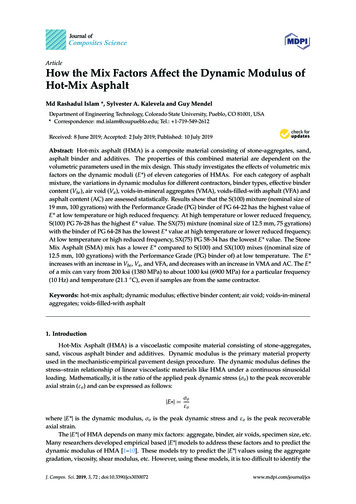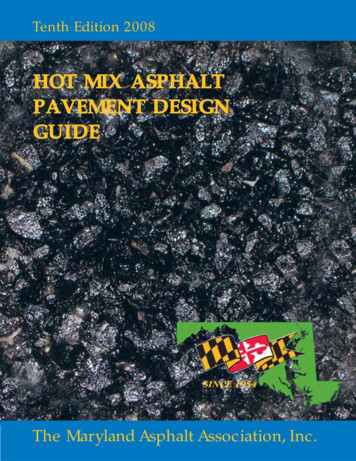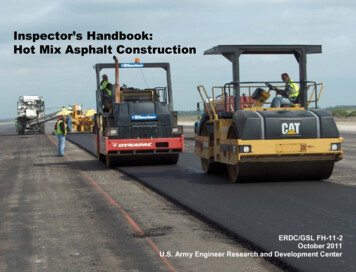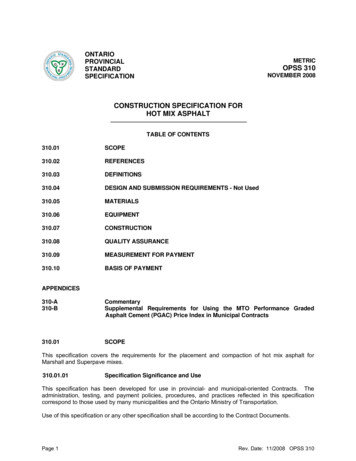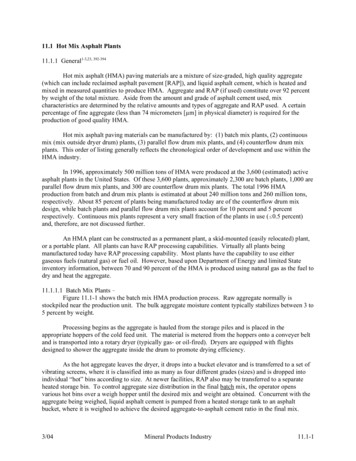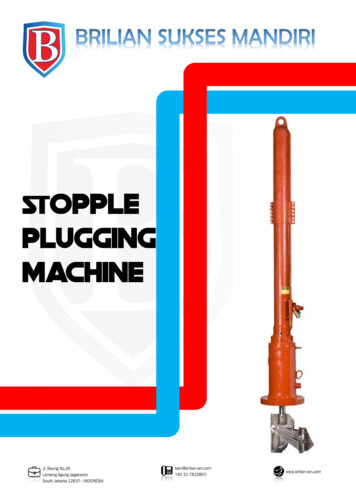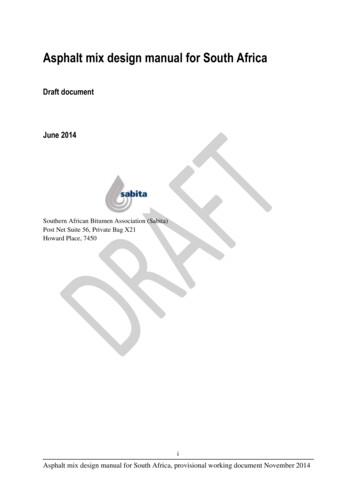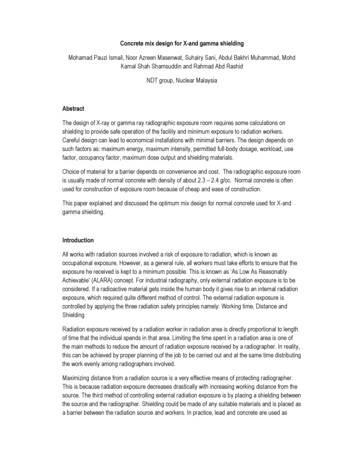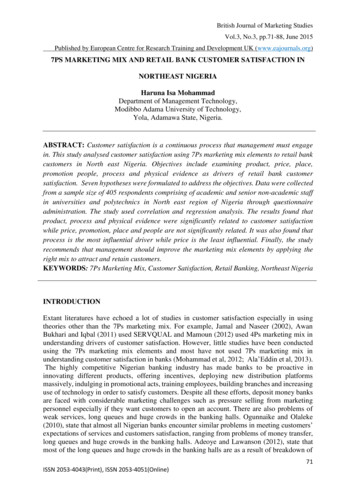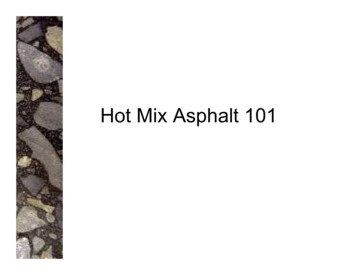
Transcription
Hot Mix Asphalt 101
Definition of HMAIn simple terms :A mixture of asphalt binder andgraded mineral aggregate, mixed atan elevated temperature andcompacted to form a relatively densepavement layer( 5% binder and 95% aggregate)
HMA Uses HighwaysAirfieldsPort FacilitiesParking LotsRecreational (Bikeways, Tennis Courts,Tracks) Hydraulic Structures Recycled Material
Components Asphalt Binder Mineral Aggregate Air Optional Modifiers/Additives:– Binder Modifiers/Additives (e.g., polymers,elastomers, fibers, rubber)– Aggregate Modifiers/Additives (e.g., lime,granulated rubber, anti-strip agents)
Components (cont.)Air voidAsphaltbinderMineralaggregateAir void
Total VolumeComponents (cont.)Air 2-20%Asphalt binder 3-8%Absorbed asphalt binder 1%Mineral aggregate 85-95%NOTE: relative size ofrectangles indicateapproximate proportionsof components in the mix.
Types of HMA Mixtures Dense-Graded (DGA)– Size evenly distributed fromsmallest to largest size (wellgraded) Open-Graded (or UniformlyGraded) Friction Course(OGFC)– Primarily coarse aggregate withfew fines Stone Mastic (Matrix) Asphalt(SMA)– Mid-size aggregate missing orreducedDense MixOpen Graded Friction CourseStone Matrix Asphalt
Hot Mix AsphaltMixture Design Objectives
Specific Mix Design Objectives Stability (permanent deformationresistance) Durability– Moisture damage and aging Fatigue cracking resistance Safety (adequate skid resistance) Resistance to thermal cracking Permeability Flexibility
Mix Design ConsiderationsMixture PropertyStabilityDurabilityFatigueResistanceSkid ResistanceFracture StrengthImperviousnessComponent and Construction Effects on Mixture PropertiesAsphaltAggregateAsphaltDegree ofStiffnessGradationContentCompactionHardSoftDense igh
Basic Mix Design PhilosophyAsphalt binder content– As much asphalt as possible for Durability Fatigue resistance Flexibility– Not so much asphalt to affect Stability Friction
Rutting and BleedingPotentialDurability and CrackingPotentialAsphalt Content Impact on HMAPerformance – Balancing ActAsphalt Content (% AC)
Consideration of StructuralComposition on Mix DesignTop 1/31 Stability2 Skid Resistance3 Durability4 Tensile Strength -Thermal CrackingMiddle 1/31 Stability2 DurabilityBottom 1/31 Fatigue Resistance2 Durability
Superpave Mixture DesignSuperior Performing AsphaltPavements
4 Steps of Superpave MixDesign1. Materials Selection2. Design Aggregate StructureTSR3. Design Binder Content4. Moisture Sensitivity
Aggregate Properties Consensus Properties - required– coarse aggregate angularity (CAA)– fine aggregate angularity (FAA)– flat, elongated particles– clay content Source Properties - agency option– toughness– soundness– deleterious materials
Asphalt BindersPolymer Modified Binders
“Ideal” Asphalt Binder Low stiffness at constructiontemperature High stiffness at high in-servicetemperature Low stiffness at low in-servicetemperature Excellent long-term durability
Sources of Asphalt Binder Asphalt occurs naturally or is obtainedthrough distillation of petroleum crudeoil. Examples of natural asphalt include thebinder in rock asphalt and Trinidad Lakeasphalt. More commonly, asphalt is obtainedthrough distillation of crude oil.
VaporPropane & ButaneNaphthaFeedstock for gasolineKeroseneAviation/domestic fuelGas OilResiduumFeedstock for dieselLubrication oilsFeedstock for asphaltbinder productionBottom of the BarrelIncreasing Value ( )Decreasing Molecular WeightRefinery AtmosphericDistillation
Polymer-Modified Binders The term “polymer” refers to a large moleculeformed by chemically reacting many (“poly”)smaller molecules (monomers) to one anotherin long chains or clusters. Physical properties of a specific polymer aredetermined by the sequence and chemicalstructure of the monomers from which it ismade.
Why Polymer-Modified Asphalt?
188oC 2hdiscrete polymer particles188oC 4hcontinue polymer strands developing200oC 2hpolymer strands developing200oC 4hmore uniform dispersion almost cross-linked
AggregatePolymer PhasePolymer PhaseVenezuelan binder modified with 7% EVA, crackedsurface, 0.5 x 0.7 mm. Wegan and Brulé, AAPT, 1999.AggregateSMA produced from the modified Venezuelan binder,0.5 x 0.7 mm. Wegan and Brulé, AAPT, 1999.AggregatePolymer Phase100 µmAggregate20 µmPolymer PhaseAggregateSMA produced from the modified Venezuelan binder,0.5 x 0.7 mm. Wegan and Brulé, AAPT, 1999.AggregateGap-graded HMA produced from the modified Venezuelanbinder, 0.5 x 0.7 mm. Wegan and Brulé, AAPT, 1999.
AggregatePolymer PhasePolymer PhaseMiddle East binder modified with 7%EVA, cracked surface, 0.5 x 0.7 mm.Wegan and Brulé, AAPT, 1999.AggregateSMA produced from the modifiedMiddle East binder, 0.5 x 0.7 mm.Wegan and Brulé, AAPT, 1999.
Rubbers and lastomers)Thermosetting
Definitions Thermoplastic materials soften andbecome plastic-like when heated butreturn to their hardened state uponcooling. Thermosetting materials flow understress when heated but, once cooled,cannot be re-softened by heat.
Binder Grade is a function ofenvironment and traffic level
Effect of Loading Rateon Binder Selection Example– for 55 mph highwayPG 64-22– for 30 mph highwayPG 70-22– for intersectionsPG 76-22NJ Standard GradeSlow - Bumpone gradeStopped - Bumptwo grades
Grading System for AsphaltBinders
Compaction level is afunction of traffic anddepth of layer
Mix size is determined bythickness of layer( 4 times DesignationName)
2) Compaction LevelLowMediumHigh3) Binder GradeHMA 12.5 H 64 Surface Course1) Nominal MaximumAggregate Size (mm)4) Location withinthe payment
2) Compaction LevelLowMediumHigh3) Binder GradeHMA 19M64 Base Course1) Nominal MaximumAggregate Size (mm)4) Location withinthe payment
Superpave Mix Selection4.759.512.519.025.037.5
Dense Graded Mixes
“Ideal” HMA Mixture Resistant to permanent deformation Resistant to fatigue cracking “Impermeable” Workable Flexible Good surface texture
Dense-Graded Mixtures10090Percent passing8070605040302010000.511.522.533.5Sieve size raised to the power of 0.4544.55
Dense-Graded Mixtures Design procedure follows AASHTO R35 Used extensively in the U.S. Binder content: typically 4.5 to 6% Field compacted air void content:typically 6 to 8%
Dense-Graded Mixtures:Advantages Good interlock of aggregate particles ifcompacted well Relatively low permeability if compacted well Strength and stiffness derived from binder andaggregate structure In NJ, generally a “stiff” mix Cheaper than other asphalt mixture types– Less asphalt binder, RAP
Dense-Graded Mixtures:Disadvantages Selection of optimum binder content:– Need enough binder for good durability andcracking resistance BUT– Not too much binder for good permanentdeformation resistance– Optimum asphalt binder content generally resultsin relatively thin binder film thickness Air void content and permeability are notoptimum for moisture damage resistance– Design for 4% AV, generally placed between 6 to8%
Open Graded Friction CourseOGFC
Open-Graded Mixtures1009080Percent passing70605040302010000.511.522.533.5Sieve size raised to the power of 0.4544.55
Open-Graded Mixtures:Advantages High permeability High asphalt binder contents resulting inthick binder films Lower noise generated by tires as comparedwith dense-graded mixtures Porous nature allows for surface water todrain off surface– Reduces splash and spray Best applied in areas of faster, continuoustraffic with minimal sharp turns
Open-Graded Mixtures:Disadvantages Aggregate interlock is shape dependent(generally poor) Lower strength and stiffness Higher costs associated with polymer-modifiedbinders, higher asphalt content and fibers Typically requires additional de-icingapplications to maintain “ice free” in coldregions Recommended not to be used in areas ofhigh, shear turning and slow moving traffic– High, shear turning may cause shoving-type failures– Slow moving traffic may clog porous structure
Wet Weather Accidents - TxDOTBefore OGFCYearAfter2001 2002 2003 2004%ChangeTotal # Accidents29514417-58.9Dry Weather Accidents10231315-2.2Wet l 0Annual Rainfall (in)Total Rain Days
Reduction in Splash andSprayNot Overlaid Yet
Reduced Pavement-RelatedNoiseSurface TypeOGFCNovachip 9.5 mm SMA12.5 mm SMAMicro-Surfacing12.5 mm SPdB(A)97.298.898.0100.598.897.8
Stone Matrix (Mastic) AsphaltSMA
Stone Mastic (Matrix) Asphalt(SMA) or Gap-Graded Mixtures1009080Percent passing70605040302010000.511.522.533.5Sieve size raised to the power of 0.4544.55
SMA Mixtures Used as a wearing course (e.g., SMA) Mix design methods:– AASHTO R46-08, Designing Stone Matrix Asphalt(SMA)– Some states have variations of AASHTO R46 Binder content: typically 5 to 7%– Polymer-modified binder and fibers used tominimize draindown Compacted air void content: typically 6 to 8%
SMA Materials Usually use locally available aggregates:– Cubical and tough– Modified (lime, antistrip liquids) Usually use locally available binders:– Modified
SMA Advantages Good aggregate interlock Low permeability Strength and stiffness derived from binder andaggregate structure Relatively high binder contents provide gooddurability Best used in areas of heavy traffic whererutting and fatigue cracking are concerns
SMA Disadvantages Asphalt suppliers not accustomed toproducing – some “growing pains” Additional time and effort in materialproduction– Aggregates! Typically use a modified binder (higher cost)– Costs typically prohibit use in “normal”traffic areas
Designing with AsphaltRubber
Asphalt Rubber Applications Asphalt rubber is the process of addingrecycled, crumb rubber to hot mix asphalt(called dry process) or the asphalt binder(called wet process) to modify the finalmixture Difficult to use in dense-graded mixtures dueto residual crumb rubber Best used in gap-graded type mixtures (SMAand OGFC)
Why Put Tire Rubber inAsphalt?Tire rubber is an engineering tool to:– Reduce cracking– Naturally increase asphalt content and asphaltfilm thickness (providing an increase indurability)– High asphalt binder viscosity preventsbleeding, flushing and drain-down– Asphalt enhancement due to rubber increasesboth the high and low temperatureperformance– Limited research has shown the addition ofrubber also reduces pavement-related noise
AR-OGFC Uses Approximately1000 Tires Per Lane-Mile
What Defines AsphaltRubber?ASTM D6114 Asphalt rubber is a blend of asphalt cement,reclaimed tire rubber and certain additives, inwhich the rubber component is at least 15%by weight of the total blend and has reacted inthe hot asphalt cement sufficiently to causeswelling of the rubber particles
Swelling of Crumb RubberElectron-microscope: Immediately after mixing (dry process)
Swelling of Crumb Rubber (cont.)Electron-microscope: 2 hours after mixing (dry process)
Asphalt RubberMethods of adding rubber to asphalt– Wet Process – rubber is added to theliquid asphalt binder before being mixedat the hot mix asphalt plant (i.e., rubberis wet before mixing)– Dry Process – rubber is added at thesame time the asphalt and aggregateare mixed (i.e., rubber is dry beforemixing)
Designing with Asphalt Rubber If wet process, previous SMA andOGFC design procedures can be used– Some state agencies utilize the “Arizona”method Only exception is evaluatingcompatibility and modification of crumbrubber with proposed base asphaltbinder
Asphalt Rubber Binder Brookfieldviscosity Resilience(ASTM D5329) Softening point Penetration Ductility
Fatigue Cracking Resistance of AsphaltRubber Mixtures vs. ConventionalMixturesGeorge B. Way, TRB 1999
AR-OGFC vs. UnmodifiedOGFCGeorge B. Way, The Asphalt Conference, 1998
AR-OGFCAR(I -O1GFC ip 95)NMovicac (I-1ro9hi-Sp 5)urfM(Iacic78roe)(U-SurSf209. ace25m(N )mJ12SM -29.5)mAm(I-7S8)12 MA.5(US12 mm1).5SmPm(SP I-78PC(U )CSD.G 22).(IPC -287)C(IPC280C(N )JP29PC CC)(IC28T0PC .T.(I- )C78T.T.E)(I78W)CPX Noise Pressure (dB(A))Tire/Pavement Noise t et al., 2005)
at the hot mix asphalt plant (i.e., rubber is wet before mixing) – Dry Process – rubber is added at the same time the asphalt and aggregate are mixed (i.e., rubber is dry before mixing) Designing with Asphalt Rubber If wet process, previous SMA and OGFC design procedures can be used – Some state agencies utilize the “Arizona” method Only exception is evaluating compatibility .File Size: 1MBPage Count: 67
